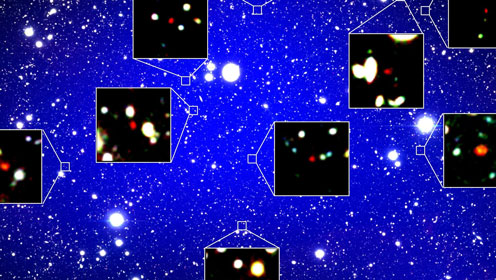Discovery of the most remote galaxy cluster in the making moves the limit of our understanding of the cosmic dawn
An international research team, including researchers from the Center of Excellence Cosmic Dawn Center (DAWN) at the University of Copenhagen, has discovered a very remote cluster of galaxies in the making – a so-called protocluster of galaxies. The distance from Earth is 13 billion light-years, and the protocluster of galaxies is thus the most remote protocluster that has been identified so far. The discovery has shed new light on the cosmic dawn, as it suggests that large galactic structures existed shortly after the birth of the universe. The discovery was recently published in the scientific journal the Astrophysical Journal.

Using three telescopes stationed on Hawaii, an international research team, including researchers from the DNRF’s research center DAWN, has identified a so-called protocluster of galaxies – a structure of galaxies still in the process of forming a cluster – which is 13 billion light-years away. This makes it the most distant protocluster ever found. The discovery can give us more information on the earliest history of the universe, as the discovery indicates that galaxy clusters already existed when the universe was only 800 million years old – equivalent to 6 percent of its present age.
Since a protocluster of galaxies is the initial stage before it develops into a galaxy cluster, researchers search for protoclusters to understand how, why, and when these galaxy clusters were created and how they developed. Meanwhile, the age of the newly discovered protocluster means that the study gives a unique insight into the early universe.
“Searching the sky for structures like this protocluster is not actually about the record, even though it is rather impressive even to be able to find it. That is an accomplishment in itself. But finding the most distant protocluster is all about moving the limits for what we are able to see – how far back in time are we able to establish a continuous baseline for our understanding of the development of the universe? When we look far away, we also look back in time. That’s why the record is scientifically significant,” said Sune Toft, head of center at DAWN and senior author behind the study.
Reveals dark skeleton of the universe
Clusters of galaxies are the largest astronomical objects in the universe. The clusters are interconnected and make up a gigantic network called the “large scale structure.” Thus, clusters of galaxies are fundamental parts of the overall structure of the universe, and that is why some of the most central questions within astronomical research involve how these clusters of galaxies formed and evolved through the 13.8-billion-year history of the universe.
“Another very important aspect of the study, which to me is extremely fascinating, is that here, we can study the distribution of galaxies in the cosmic web and relate what we see – the light from the stars – to the underlying distribution of dark matter,” said Professor Toft. He added:
“Dark matter really drives everything in the development of galaxies. We just can’t see it. But if we become able to place the galaxies in the cosmic web and track the developments, then in turn we can see how dark matter impacts what we can see. That is really the big, unanswered question here. We actually don’t know the precise relation between dark matter and matter that emits light at the moment. But studies like this provide us with tools to tackle this problem observationally,” Professor Toft explained. “Unveiling the dark skeleton of the universe is really the ultimate goal we have before us with this.”
